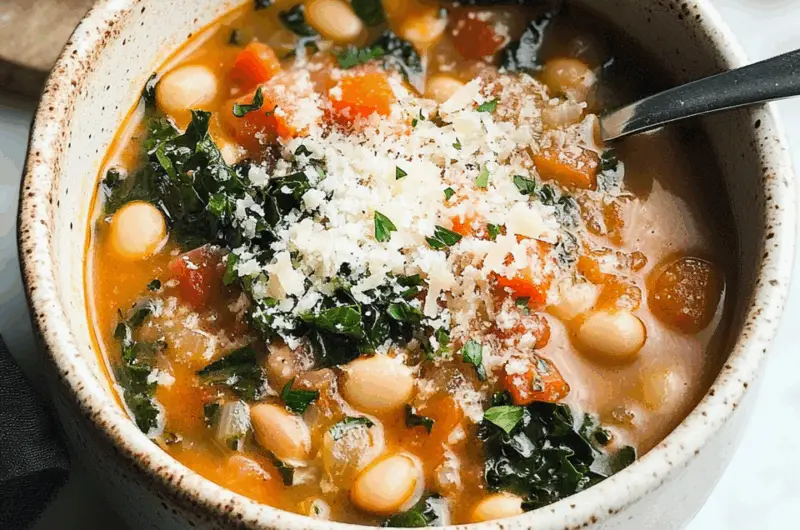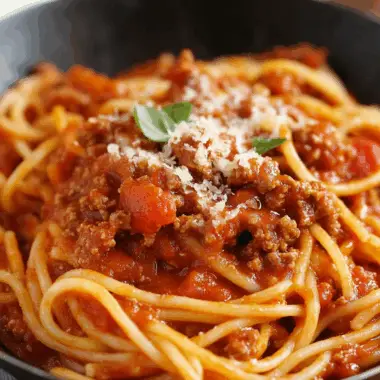The Ribollita is a true Italian comfort dish that hails from the heart of Tuscany. Originally a peasant dish, its name means “reboiled,” reflecting its origins of being reheated over several days. This hearty soup uses simple, everyday ingredients like cannellini beans, kale, tomatoes, and crusty bread to create a deeply flavorful, rustic meal that warms you from the inside out. Today, Ribollita is loved not just in Italian households, but globally as a soul-satisfying vegetarian soup that’s as healthy as it is delicious. It’s an ideal make-ahead meal since the flavors deepen as it sits. Plus, it’s a fantastic way to use up leftover veggies and stale bread. Whether you’re embracing meatless Mondays, craving something cozy, or simply wanting to try a traditional Italian dish, Ribollita never disappoints.
Full Recipe:
Ingredients:
-
2 tablespoons olive oil
-
1 onion, finely chopped
-
2 carrots, diced
-
2 celery stalks, diced
-
3 cloves garlic, minced
-
1 teaspoon salt
-
1 teaspoon pepper
-
1 teaspoon red pepper flakes (optional)
-
1 tablespoon tomato paste
-
1 teaspoon Italian seasoning
-
1 can diced tomatoes
-
4 cups vegetable broth
-
1 can cannellini beans, drained and rinsed
-
2 cups chopped kale
-
1 zucchini, chopped
-
2 cups day-old crusty bread, torn into pieces
-
Fresh basil or parsley, for garnish
-
Grated parmesan cheese, for serving (optional)
Directions:
-
Heat olive oil in a large pot over medium heat. Add onions, carrots, and celery. Sauté for 8-10 minutes, until softened.
-
Stir in garlic, salt, pepper, red pepper flakes, tomato paste, and Italian seasoning. Cook for 2-3 minutes until fragrant.
-
Add diced tomatoes, broth, and cannellini beans. Bring to a simmer and cook for 15 minutes.
-
Add kale and zucchini, and continue to simmer for another 10-15 minutes until vegetables are tender.
-
Stir in the torn bread and simmer for another 5 minutes, letting the bread absorb the broth.
-
Serve hot, garnished with fresh herbs and optional parmesan cheese.
Prep Time: 10 minutes | Cooking Time: 40 minutes | Total Time: 50 minutes
Kcal: 295 kcal | Servings: 4 servings
Discover the Rustic Charm of Tuscan Ribollita Soup
Tuscan Ribollita Bean Soup is one of Italy’s most iconic and comforting dishes, steeped in centuries-old tradition and frugal ingenuity. Translating literally to “reboiled,” Ribollita is more than just a soup it’s a celebration of Tuscan peasant cuisine where nothing goes to waste. This hearty, vegetable-rich stew was born from the necessity of reusing leftovers, combining stale bread with cannellini beans, leafy greens, and whatever vegetables were available in the pantry or garden.
With its thick, almost stew-like consistency and deeply savory flavor, Ribollita is a bowl of warmth that tells a story. In today’s kitchens, it continues to be appreciated for its simplicity, nutritional value, and the soul-soothing satisfaction it delivers with every spoonful.
The Origin and Meaning Behind Ribollita
The origins of Ribollita stretch back to Medieval times, when servants would collect leftover bread and vegetables from the meals of wealthy households. They’d boil everything together into a single, hearty dish, and then reheat it over several days. The word “ribollita” literally means “reboiled” in Italian, referring to the process of reheating and intensifying the flavors of the soup over time.
This humble beginning gave rise to one of Tuscany’s most iconic recipes. Though it began as a frugal solution to avoid waste, today Ribollita is celebrated for its rich, robust flavor and wholesome ingredients. It’s a classic example of cucina povera Italy’s traditional “poor cooking” that emphasizes resourcefulness, seasonal produce, and simple techniques that bring out deep, natural flavors.
A Soup That Gets Better With Time
One of Ribollita’s most fascinating qualities is that it actually improves with age. While it’s certainly delicious straight from the pot, it becomes even more flavorful after sitting for a day or two in the refrigerator. As it’s reheated true to its name the flavors meld beautifully, and the consistency becomes even thicker and more satisfying.
Many cooks recommend making a double batch specifically so you can enjoy the soup across multiple days. The transformation is remarkable: the bread softens and dissolves into the broth, the beans become silkier, and the greens infuse the mixture with their earthy character.
A Celebration of Seasonal, Local Ingredients
True to its rustic roots, Ribollita uses simple, seasonal vegetables that would have been available in every Tuscan household or market. Kale (especially the curly cavolo nero, or Tuscan kale), cannellini beans, carrots, onions, celery, and tomatoes make up the base of the soup. These are the ingredients that not only nourish but also represent a traditional Mediterranean diet.
The stale bread used in Ribollita is usually a crusty country loaf, like Tuscan pane sciocco, which is traditionally made without salt. When added to the soup, it thickens the texture and adds a comforting, doughy backbone to the dish.
Today, cooks around the world adapt Ribollita to what’s in season or what’s available in their pantry. Zucchini, spinach, cabbage, or even potatoes can be added for extra bulk and nutrition. The beauty of Ribollita lies in its flexibility—no two pots ever need to be exactly alike.
A Nutrient-Packed, Plant-Based Meal
Ribollita is as nutritious as it is delicious. With its abundance of vegetables, fiber-rich beans, and heart-healthy olive oil, it’s a meal that checks every box in terms of wellness. This soup is naturally vegetarian and easily made vegan, making it perfect for anyone following a plant-based lifestyle or simply looking to reduce their meat consumption.
Kale is rich in vitamins A, C, and K, as well as calcium and antioxidants. Cannellini beans provide plant-based protein and fiber, which supports digestion and keeps you feeling full. The mix of vegetables offers a rainbow of nutrients, while the olive oil adds anti-inflammatory benefits and a luxurious mouthfeel.
In short, Ribollita is a guilt-free comfort food that satisfies cravings and supports a healthy lifestyle.
How Ribollita Reflects Tuscan Culinary Philosophy
Tuscany is a region known for its straightforward, rustic cuisine. From Panzanella to Bistecca alla Fiorentina, simplicity is king and Ribollita exemplifies this ethos beautifully. There’s nothing fancy or extravagant about the soup, but it relies on quality ingredients and the slow melding of flavors to create something unforgettable.
Ribollita is also a dish that reflects community and tradition. It’s the kind of meal that brings people together around the table, often served with a drizzle of fresh olive oil, a grind of black pepper, and a chunk of crusty bread on the side. It’s a dish that feels like home.
Modern Twists and Creative Variations
While the traditional Ribollita recipe is close to perfect, there’s always room for creativity in the kitchen. Some modern cooks add a touch of red wine or a parmesan rind to deepen the flavor of the broth. Others experiment with different greens, such as Swiss chard or spinach, or include more legumes like chickpeas or lentils.
You can also switch up the texture depending on your preferences some like it thick and chunky, others blend a portion of the soup for a smoother, creamier finish.
And while the original version relies on vegetable broth, you could use a light chicken broth for added richness if you’re not strictly vegetarian. Topping the soup with a poached egg or crumbled feta is another gourmet twist that can elevate Ribollita from rustic to restaurant-worthy.
Serving Suggestions and Meal Pairings
Ribollita is a complete meal in itself, but it also pairs wonderfully with simple accompaniments. Serve it with a glass of dry Italian red wine like Chianti or Montepulciano, and a fresh green salad with lemon vinaigrette for contrast.
A slice of toasted bread rubbed with garlic and drizzled with olive oil makes a perfect side. And if you’re entertaining, start with a small antipasto plate of olives, marinated vegetables, and cheese to set the tone for your Tuscan-themed meal.
For dessert, consider something light and fresh like a citrus sorbet or panna cotta with berries to balance the richness of the soup.
Advertisement
Why Ribollita Is the Perfect Soup for Any Season
Although Ribollita is traditionally associated with the colder months due to its hearty, warming nature, it’s truly a year-round recipe. In the winter, it provides much-needed comfort, nourishment, and warmth. In the summer or fall, it’s a great way to use garden vegetables and enjoy a lighter meal that still satisfies.
The versatility of Ribollita makes it a go-to for weeknight dinners, meal prep lunches, or even elegant gatherings. It freezes well, reheats beautifully, and always manages to taste better with time.
Conclusion:
Tuscan Ribollita Bean Soup is far more than just a soup it’s a story of tradition, simplicity, and love passed down through generations. Its humble roots speak volumes about Italian culture and the art of turning ordinary ingredients into something extraordinary.
With its deep flavor, satisfying texture, and nourishing ingredients, Ribollita is a dish that transcends its origins and becomes a timeless staple in any kitchen. Whether you’re exploring Italian cuisine for the first time or you’re a seasoned home cook looking for something comforting and authentic, Ribollita is a must-try.








